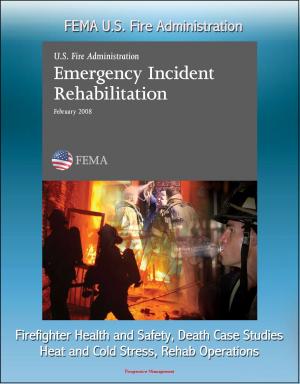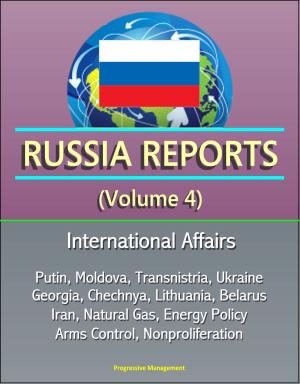A Comparative Analysis Into U.S. Military Abuses at the My Lai Massacre and Abu Ghraib Prison Scandal: Terrorists, Vietnam War, Gangs, Psychology, Deradicalization, Models Explain Abuse Participation
Nonfiction, History, Military, Social & Cultural Studies, Political Science| Author: | Progressive Management | ISBN: | 9781311540874 |
| Publisher: | Progressive Management | Publication: | March 16, 2016 |
| Imprint: | Smashwords Edition | Language: | English |
| Author: | Progressive Management |
| ISBN: | 9781311540874 |
| Publisher: | Progressive Management |
| Publication: | March 16, 2016 |
| Imprint: | Smashwords Edition |
| Language: | English |
Professionally converted for accurate flowing-text e-book format reproduction, this unique study analyzes various models and their subcomponent elements from four bodies of literature: psychology; terrorist engagement; terrorist disengagement, deradicalization, and non-radicalization; and gang involvement, to better understand the disparate behavior between abusers and whistleblowers.
Incidents of abuse by U.S. service members, even if few and far between, have nearly irreversible impacts on the United States, including straining foreign relations, decreasing public support of U.S. policy, and negating counterterrorism efforts. A lot of research exists to discover why individuals participate in abuse, but little is known why individuals report abuse.
After extracting applicable elements, a preliminary model to explain the difference between abusers and whistleblowers is formed, and then tested comparatively against two case studies: the My Lai massacre, and the Abu Ghraib prison scandal. The preliminary model is then discarded of elements that failed to explain the differences in behavior, leaving a final model. Measures to deter abuse and encourage reporting are then derived from this final model, leaving the reader with an enhanced understanding of not just why individuals participate in abuse, but why, under relatively similar conditions, others actively stop or report the abuse.
CHAPTER I * INTRODUCTION * A. MAJOR RESEARCH QUESTION * B. SIGNIFICANCE OF THE RESEARCH QUESTION * C. LITERATURE REVIEW * 1. Psychology * 2. Terrorist Engagement * 3. Terrorist Deradicalization, Disengagement, and Non-radicalization * 4. Gangs * 5. Primary Sources and Official Reports * D. POTENTIAL EXPLANATIONS AND HYPOTHESES * E. RESEARCH DESIGN * F. THESIS OVERVIEW AND CHAPTER OUTLINE * CHAPTER II * THE CASE STUDIES * A. MY LAI * 1. Background: The Vietnam War and an Elusive Enemy * 2. Task Force Barker * 3. The Orders * 4. The Massacre * B. ABU GHRAIB * 1. Background: September 11, 2001 * 2. The War on Terror * 3. The Elusive Enemy and an Undefined Mission * 4. The Prison System * 5. Abu Ghraib * CHAPTER III * A PRELIMINARY MODEL TO EXPLAIN PARTICIPATION IN ABUSE * A. PSYCHOLOGY * 1. Stanley Milgram and the Shock Experiment * 2. Philip Zimbardo and the Stanford Prison Experiment * B. TERRORIST ENGAGEMENT * 1. John Horgan's Model of Predisposing Factors for Terrorist Engagement * 2. John Horgan's Catalyst Event for Involvement * C. TERRORIST DERADICALIZATION, DISENGAGEMENT, AND NON-RADICALIZATION * 1. John Horgan's Model for Psychological Disengagement from Terrorism * 2. Kim Cragin's Conceptual Model for Non-radicalization * D. GANG INVOLVEMENT * 1. Martin Sanchez Jankowski's Model of Reasons to Join a Gang * 2. Predictors of Gang Involvement from Mobile Youth Survey Data * 3. The Additional Element of Age * E. OFFICIAL REPORTS ON CASE STUDIES * 1. Peers Inquiry Model on the My Lai Massacre * 2. Schlesinger Report's Model of Abusive Treatment at Abu Ghraib * CHAPTER IV * A PRELIMINARY MODEL TO EXPLAIN PARTICIPATION IN ABUSE * A. SEQUENTIAL NATURE * 1. Testing Sequential Nature against the My Lai Case Study * 2. Testing Sequential Nature against the Abu Ghraib Case Study * B. ANXIETY AND FEAR * 1. Testing Anxiety and Fear against the My Lai Case Study * 2. Testing Anxiety and Fear against the Abu Ghraib Case Study * C. DEINDIVIDUATION * 1. Testing Deindividuation against the My Lai Case Study * 2. Testing Deindividuation against the Abu Ghraib Case Study * D. FAMILY OBLIGATIONS * 1. Testing Family Obligations against the My Lai Case Study
Professionally converted for accurate flowing-text e-book format reproduction, this unique study analyzes various models and their subcomponent elements from four bodies of literature: psychology; terrorist engagement; terrorist disengagement, deradicalization, and non-radicalization; and gang involvement, to better understand the disparate behavior between abusers and whistleblowers.
Incidents of abuse by U.S. service members, even if few and far between, have nearly irreversible impacts on the United States, including straining foreign relations, decreasing public support of U.S. policy, and negating counterterrorism efforts. A lot of research exists to discover why individuals participate in abuse, but little is known why individuals report abuse.
After extracting applicable elements, a preliminary model to explain the difference between abusers and whistleblowers is formed, and then tested comparatively against two case studies: the My Lai massacre, and the Abu Ghraib prison scandal. The preliminary model is then discarded of elements that failed to explain the differences in behavior, leaving a final model. Measures to deter abuse and encourage reporting are then derived from this final model, leaving the reader with an enhanced understanding of not just why individuals participate in abuse, but why, under relatively similar conditions, others actively stop or report the abuse.
CHAPTER I * INTRODUCTION * A. MAJOR RESEARCH QUESTION * B. SIGNIFICANCE OF THE RESEARCH QUESTION * C. LITERATURE REVIEW * 1. Psychology * 2. Terrorist Engagement * 3. Terrorist Deradicalization, Disengagement, and Non-radicalization * 4. Gangs * 5. Primary Sources and Official Reports * D. POTENTIAL EXPLANATIONS AND HYPOTHESES * E. RESEARCH DESIGN * F. THESIS OVERVIEW AND CHAPTER OUTLINE * CHAPTER II * THE CASE STUDIES * A. MY LAI * 1. Background: The Vietnam War and an Elusive Enemy * 2. Task Force Barker * 3. The Orders * 4. The Massacre * B. ABU GHRAIB * 1. Background: September 11, 2001 * 2. The War on Terror * 3. The Elusive Enemy and an Undefined Mission * 4. The Prison System * 5. Abu Ghraib * CHAPTER III * A PRELIMINARY MODEL TO EXPLAIN PARTICIPATION IN ABUSE * A. PSYCHOLOGY * 1. Stanley Milgram and the Shock Experiment * 2. Philip Zimbardo and the Stanford Prison Experiment * B. TERRORIST ENGAGEMENT * 1. John Horgan's Model of Predisposing Factors for Terrorist Engagement * 2. John Horgan's Catalyst Event for Involvement * C. TERRORIST DERADICALIZATION, DISENGAGEMENT, AND NON-RADICALIZATION * 1. John Horgan's Model for Psychological Disengagement from Terrorism * 2. Kim Cragin's Conceptual Model for Non-radicalization * D. GANG INVOLVEMENT * 1. Martin Sanchez Jankowski's Model of Reasons to Join a Gang * 2. Predictors of Gang Involvement from Mobile Youth Survey Data * 3. The Additional Element of Age * E. OFFICIAL REPORTS ON CASE STUDIES * 1. Peers Inquiry Model on the My Lai Massacre * 2. Schlesinger Report's Model of Abusive Treatment at Abu Ghraib * CHAPTER IV * A PRELIMINARY MODEL TO EXPLAIN PARTICIPATION IN ABUSE * A. SEQUENTIAL NATURE * 1. Testing Sequential Nature against the My Lai Case Study * 2. Testing Sequential Nature against the Abu Ghraib Case Study * B. ANXIETY AND FEAR * 1. Testing Anxiety and Fear against the My Lai Case Study * 2. Testing Anxiety and Fear against the Abu Ghraib Case Study * C. DEINDIVIDUATION * 1. Testing Deindividuation against the My Lai Case Study * 2. Testing Deindividuation against the Abu Ghraib Case Study * D. FAMILY OBLIGATIONS * 1. Testing Family Obligations against the My Lai Case Study















